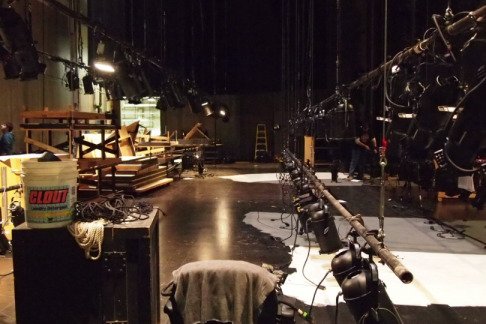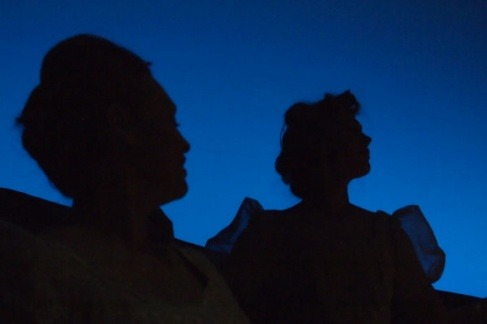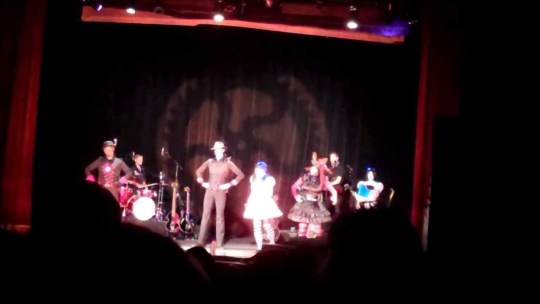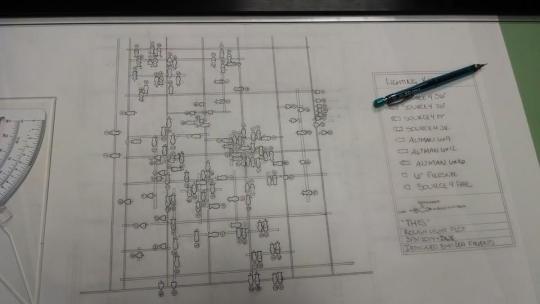Don't wanna be here? Send us removal request.
Photo

2014 - Secret Garden - Cornish College of the Arts
Scenic and electrics playing nice.
1 note
·
View note
Photo

2014 - Secret Garden - Cornish College of the Arts
Actress shadows on the Cyc. 8 ColorForce 72 front-lit.
0 notes
Photo

2013 - Neverwhere - Cornish College of the Arts
The darkest show I've ever worked on. 2 Radiance hazers, 2 fog machines, 1 straight-down Source 4 36*, 2 low angled side Source 4 14*
2 notes
·
View notes
Photo

2013 - Steam Powered Giraffe - Historic Everett Theatre
Last minute gobo addition!
27 notes
·
View notes
Photo

2013 - Ajax in Iraq
The duties of a Master Electrician
0 notes
Photo

2014 - This
First attempt at hand-drafting a light plot.
4 notes
·
View notes
Photo

2013 - Neverwhere - Cornish College of the Arts
Testing the limits of 2 Radiance hazers and 2 fog machines.
0 notes
Text
In Class Questions 2/3
What conversation is my audience starting by visiting my site?
My audience is opening up a line of communication to learn more about me and my work.
Which of those purposes do I want to say/show on my site? Which genres work best for those purposes?
The purpose of my website is primarily description and process of the works I've done. I would consider this to be most successful as a personal website, describing my process and motivation for all the works I do.
I still need to add more comprehensive photos and descriptions of my work, a statement about myself and my resume.
0 notes
Text
Project 3 Brainstorm
My main goal for this project is to be able to communicate with and market myself to other professionals in the field. I plan for my website to be easy to navigate with plenty of photo/video documentation of all my works along with short descriptions. I will link my website to my Facebook and my blog as well to create a more personal and real connection between me and my readers. My website will be organized and links will be easy to understand and follow.
0 notes
Text
In-class questions
What are you taking away from this project of analyzing one artists' approach to online identity?
I've researched many artists' online presences in looking for one to focus on, and have seen many different ways of going about organizing and representing works on a digital platform.
What questions did you have answered?
How other artists dealing primarily with light thoroughly showcase their work online.
What questions do you still or now have?
What is the best way to get exposure and build the virtual network with other artists.
What has this project suggested about how you want to develop your own identity on sites and social media?
I want to have a clean, professional, inviting website that is well organized and has thorough documentation of each one of my works. As far as social media, I hope to consistently update my readers with new projects.
0 notes
Text
Bruce Munro: Artist Embracing the 21st Century
Bruce Munro is a well-known artist from the UK whose medium is mostly large-scale light-based installations. His installations are beautiful and being light-based, not all that easy to capture on film.

One of his installations entitled “Fireflies” (pictured) is of the most impressive to me, not only because of its complicated and beautiful nature, but also the way he has chosen to represent it in his online portfolio. He takes multiple photos of different angles of each installation and accompanies the photos with videos of the process of installation as well as the movement and final product of each piece. His videos are incredibly interesting in showing the process of installing each piece, but also a very useful tool as an artist to document the final piece as it moves, shifts, and changes color.

As an artist that deals primarily in light, it’s always important to see how to represent work that not only shifts and changes, but also depends a great deal on environment. Munro is a great example of how to use film with a light-based installation to the advantage. His images often use the forced perspective of the camera to highlight or accentuate different parts of the piece. He also creates illusions based around the angle of the camera in respect to the piece. “Fagin’s Urchins” (pictured) uses forced perspective and view to give the illusion of these orbs floating or flying above the surface of the water.
With an artist who’s so talented and heavily documented, he needs a website that will beautifully and simply showcase his work. The homepage of his website does exactly that.

Off the bat, you’re greeted with a slideshow of his five most recent works followed down the page with links to collections of his installations, sculptures and commissioned work. The top of his page is lined with tabs to navigate you to different pages, making moving about the website incredibly easy and effortless. Munro also uses a lot of small thumbnails of his works as a link to more information and more documentation on that specific piece.
His website is definitely geared toward a specific audience. I would personally assume it’s focused more toward artists. Each one of his pieces includes a description noting not only the materials, location and date of installation but also his motivation and inspiration for his design.
I don't necessarily agree with all of his web design choices - everything is rather large on the page making it hard to take in much information at once. This requires a lot of scrolling and page navigation which often leads to losing the readers' attention.
Overall, Munro is an amazing artist with a strong online presence and beautiful, effective representation of his work. His website could use a little work to make it a little easier to take in information, but it is very clean and organized. If there's any artist I admire as a successful professional, it would be Munro.
1 note
·
View note
Text
Bruce Munro
Bruce Munro is a well-known artist from the UK whose medium is mostly large-scale light-based installations. His installations are beautiful and being light-based, not all that easy to capture on film. One of his installations entitled “Fireflies” is of the most impressive to me, not only because of its complicated and beautiful nature, but also the way he has chosen to represent it in his online portfolio. He takes multiple photos of different angles of each installation and accompanies the photos with videos of the process of installation as well as the movement and final product of each piece. His videos are incredibly interesting in showing the process of installing each piece, but also a very useful tool as an artist to document the final piece as it moves, shifts, and changes color.
As an artist that deals primarily in light, it’s always important to see how to represent work that not only shifts and changes, but also depends a great deal on environment. Munro is a great example of how to use film with a light-based installation to the advantage. His images often use the forced perspective of the camera to highlight or accentuate different parts of the piece. He also creates illusions based around the angle of the camera in respect to the piece. “Fagin’s Urchins” uses forced perspective and view to give the illusion of these orbs floating or flying above the surface of the water.
With an artist who’s so talented and heavily documented, he needs a website that will beautifully and simply showcase his work. The homepage of his website does exactly that. Off the bat, you’re greeted with a slideshow of his five most recent works followed down the page with links to collections of his installations, sculptures and commissioned work. The top of his page is lined with tabs to navigate you to different pages, making moving about the website incredibly easy and effortless.
His website is definitely geared toward a specific audience.I would personally assume it’s focused more toward artists. Each one of his pieces includes a description noting not only the materials, location and date of installation but also his motivation and inspiration for his design.Munro uses a lot of small thumbnails of his works as a link to more information and more documentation on that specific piece.
0 notes
Text
2.2
In looking for an artist, I'm definitely first and foremost going to look for someone who works in lighting arts. Whether that's theatrical or sculptural. I want to see their individual representations of themselves as an artist of light as well as the format of their work.
Bruce Munro: http://www.brucemunro.co.uk/ Munro is probably going to be my top choice as an artist to analyze. Not only do I love his work, but I also really appreciate and admire his online presence. Not only does he have pictures and a written description of each one of his installations and sculptures, but he also has videos of each one in "action", which I believe is a very integral part of demonstrating art with light.
Leo Villareal: http://villareal.net/ Villareal is a very interesting artist as well. He fits the criteria of being an artist working with light. I find his website very dynamic in its fluidity and movement, and that's something I'm very interested in integrating into my own online portfolio. He has less writing about his work but often provides short videos talking about them, which is an interesting outlet I hadn't considered.
Carlos Cruz-Diez: http://www.cruz-diez.com/ Cruz-Diez makes some amazing conceptual light sculptures that are very difficult to display on camera. I do like the representations of his online art portfolio. I don't necessarily like his website as a whole, but I do like the descriptions he provides with his work.
0 notes
Text
2.1
"How do the artists' purposes for using social media play into the identity they are creating?"
This is something that has been brought up this past week and something I am very interested in learning more about. I'm curious to see why artists chose the different outlets, modes and mediums they do to represent themselves.
I'm curious to see how artists with similar mediums as mine represent and document their work. I've always had trouble figuring out the best ways to document my work and use it to represent me as an artist, as using a camera doesn't always capture light the way you would expect or want. I'm also very interested to see how they talk about their work. Artist statements and work descriptions are very important and I want to see how they document that online.
I want to learn more about keeping a website. Less about a blog or social media, as that's something I'm very comfortable with. I want to see how artists' websites are formatted, the movement from one page to another and how they use space and formatting to their advantage.
As an artist, I would like to gain more knowledge about how to professionally write about my work in an online platform and how to tie descriptions and statements into my visual representations - whether pictures or videos, etc.
0 notes
Photo







Last House Standing Ben Marcin
"One of the architectural quirks of certain cities on the eastern seaboard of the U.S. is the solo row house. Standing alone, in some of the worst neighborhoods, these nineteenth century structures were once attached to similar row houses that made up entire city blocks. Time and major demographic changes have resulted in the decay and demolition of many such blocks of row houses. Occasionally, one house is spared - literally cut off from its neighbors and left to the elements with whatever time it has left. And then there’s the lingering question of why a single row house was allowed to remain upright. Still retaining traces of its former glory, the last house standing is often still occupied."
2K notes
·
View notes
Text
Who doesn't market themselves online?
I mean, seriously.
Today - in the year 2014 - there really aren't many professionals (especially artists) that can make it without flaunting their talent where over 3 billion online users can see. Personally that's a huge deal in my industry. Being a lighting designer requires a lot of visual representation, and having a blog, website or various social media outlets allows me to easily share all of my designs with anyone who wants to see them. A director wants to be able to "Google" my name and find all the work I've put into all the shows I've been a part of, which is much more convenient than having to wait for a portfolio. Some people might argue that their work can only be properly represented when printed and archived in a physical, hard cover portfolio. That's certainly not the case for everyone. Especially someone whose industry is so reliant on technology.
Okay. I'm just as guilty as anyone else. Maybe my online presence isn't exactly everything I could hope for it to be. I'm sure I have an old MySpace page floating around somewhere that really has no connection whatsoever to who I am now as an adult and a professional designer.
As I'm reshaping and recreating my online persona from my middle/high school years, I'm focusing more on writing not so much for my friends, but more for people who have the same interests as me. I write for designers, directors, actors, stgehands and electricians - the people directly related with the biggest, most important parts of my life. Before, I saw social media as a way to develop myself as a person - to really find out what I liked and didn't like and how I wanted my family and my peers to see me. As I get older, I view social media more as a way to develop who I am as a professional and develop networks of other working professionals to collaborate with and learn from.
0 notes
Quote
I don’t think art is about expression. I don’t think that’s its primary motive. The primary motivation is communion with your fellow human beings.
Nic Pizzolatto, quoted by Andrew Romano, Inside the Obsessive, Strange Mind of True Detective’s Nic Pizzolatto, The Daily Beast (via theunderliner)
13 notes
·
View notes